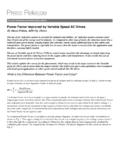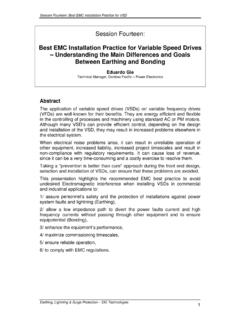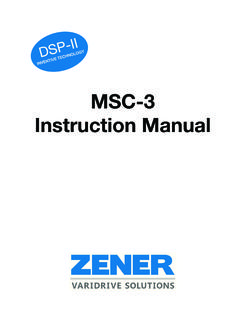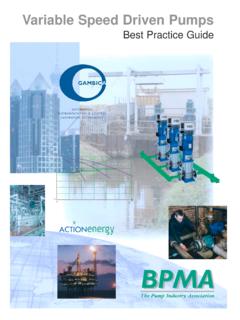Transcription of EMC and variable speed drives - The Brady Waters Company
1 EMC and variable speed drives EMC stands for electromagnetic compatibility the ability of electric and electronic devices to work properly in the environment for which they are designed. For this purpose the environment is defined as the expected level of radio frequency disturbances present. The term usually is considered to refer to high frequency disturbances, both conducted and radiated, in the frequency range 9 kHz to 400 GHz, although technically low level issues (< 2. kHz) are included. The compatibility consists of two parts: immunity (a product may not be disturbed when used in its proper environment) and emission (a product may not emit too much when installed in its proper environment).
2 The following picture illustrates the relative levels required for immunity and emissions in various environments. Note the logarithmic vertical scale. Figure 1: Allowed levels of emission and required levels of immunity. The fundamental global standard in the field is CISPR11, also known as EN55011. This standard is applicable in all countries to so called ISM. equipment = equipment or appliances designed to generate and use locally radio frequency energy for industrial, scientific, medical, domestic or similar purposes, excluding applications in the field of telecommunications. CISPR is charged with protecting the radio spectrum against interference, so it can be used for communication purposes.
3 Therefore the focus is on how much background noise can exist in the environment and still allow radio transmissions to be heard clearly. Technically, the standard concerns itself with conducted emissions on the mains cables and other cables in the frequency range 150 kHz to 30 MHz and radiated emissions in the area 30. MHz to 1 GHz no limits at present exist for higher frequencies, although they are being discussed for edition 6 of the standard. Exceeding the allowed limits by equipment sold in large numbers would have a deleterious influence on radio communications, which is not an acceptable situation. The focus on conducted emissions for the lower frequencies ( to 30 MHz). is due to the fact that the wavelength is such that parts of the grid can function as an antenna and radiate disturbances.
4 The wavelength at 150 kHz is about 2000 m a quarter wave antenna would be about 500 m long. The corresponding values for 30 MHz are 10 m and m, respectively. These are lengths that clearly exist in the grid supplying the device. This band covers the common long wave, medium wave and short wave bands. At higher frequencies the emphasis shifts to direct radiated disturbances . the impedance in the mains at these frequencies becomes so high that it dampens any disturbance. Here the radiation comes directly from either the motor cables or from the switching elements themselves. The bands from 30. MHz to 1 GHz (HF, VHF, UHF) (later up to 400 GHz) cover services like TV, FM. radio, WLAN, mobile phones, radar etc.
5 Based on the global noise levels that can be accepted and do not endanger radio communications limits have been set on how many individual devices can transmit. In this context the transmitters are defined as non-intentional transmitters, equipment in which the use of RF energies is not central to the functioning of the said equipment. In this calculation the expected number of transmitters has been taken into account, so that if a large number of emitters are expected in a given location their individual limits are low, whereas if the number is small the individual levels can be slightly higher, without exceeding the total allowed level. This implies that household goods (TVs, radios, cooking ranges, lighting equipment, which are connected in large numbers to the grid) have low limits whereas industrial equipment (whose numbers are much lower) have higher limits.
6 The standard does differentiate between devices of different rated power, as larger devices generally generate more noise than smaller ones. This, however, is only generally true badly designed small devices can generate much higher levels of emissions that well-designed larger ones a badly designed electronic ballast for a fluorescent lamp (power about 50 W) can generate more emissions than a well-designed 11 kW drive . In addition, aging of components in commercial equipment constitutes an unknown risk, as the emission levels might increase as the product ages. CISPR 11 divides equipment into two groups: Group 1 equipment: Group 1 contains all equipment in the scope of the standard which is not classified as Group 2 equipment.
7 Group 2 equipment: Group 2 contains all ISM RF equipment in which radio-frequency energy in the frequency range 9 kHz to 400 GHz is intentionally generated and used or only used, in the form of electromagnetic radiation, inductive and/or capacitive coupling, for the treatment of material or inspection/analysis purposes. All variable speed drives fall into Group 1. The number and location of the equipment being considered is reflected in the division into classes: Class A equipment is equipment suitable for use in all establishments other than domestic and those directly connected to a low voltage power supply network which supplies buildings used for domestic purposes. Class B equipment is equipment suitable for use in domestic establishments and in establishments directly connected to a low voltage power supply network which supplies buildings used for domestic purposes.
8 Translated: Class B equipment is intended for use in domestic and similar environments (houses, apartment blocks, possibly shopping malls, light industry etc.), Class A equipment in an industrial environment. The background of the definition is in the fact that in such an environment the power supply owner has no control of who connects what to his supply whereas in Class A the supply transformer and what is connected to it is under some degree of control. Figure 2: Classification in CISPR 11. CISPR 11 is a global standard according to the introduction product standards (for specific product groups) can be made and they will then take precedence over the requirements of CISPR 11. The need for product standards may come from some specific issue related to that product group.
9 In the case of variable speed drives the fact that their numbers in commercial environments is relatively low. IEC SC22G, responsible for variable speed drives has written a VSD specific EMC standard, IEC 61800-3, now in edition 2, edition 3 is being prepared in a normal maintenance cycle. In this standard the basic assumption has been that variable speed drives are limited in number compared to household and similar equipment and that they need a professional to install them, a professional who can be trusted to understand the need for a correct installation of EMC related parts and components. The standard is valid for a as PDS (power drive systems) consisting of drive and motor plus all other required auxiliary components the actual driven machine is excluded.
10 drives with a rated current > 400 A, rated voltage >. 1000 V and drives used in IT (floating) networks are excluded, as are drives where the required filter could have a negative impact on the dynamic performance of the system. The two first ones are due to the fact that no defined measurement setups exist (due to high voltages and currents), the IT. exclusion comes from the impossibility of making reliable voltage measurements from a phase to ground. Under the European EMC Directive the supplier is still responsible for making sure that the product and installation does not disturb others. This standard defines the following environments where the drive is installed: First environment Environment that includes domestic premises, it also includes establishments directly connected without intermediate transformers to a low-voltage power supply network which supplies buildings used for domestic purposes.






